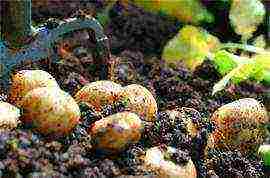Content
Surinamese pipa - toad, which can be found in the waters of the Amazon Basin in South America. This species belongs to the pipin family, a class of amphibians. A unique frog is able to bear offspring right on its back for almost three months.

Description and structural features of the Surinamese pipa
A distinctive feature of an amphibian is the structure of its body. If you look at photo of pipa of Suriname, you might think that the frog accidentally fell under the ice rink. A thin, flattened body looks more like an obsolete leaf of a tree than a living inhabitant of the warm waters of a tropical river.
The head is triangular in shape, and is also flattened like the body. Tiny eyes, devoid of eyelids, are located at the top of the muzzle. It is noteworthy that frog pipa surinamese missing tongue and teeth. Instead, at the corners of the toad's mouth there are skin patches that look like tentacles.
The front legs end in four long toes without claws, without membranes, as is the case with ordinary frogs. But the hind limbs are equipped with powerful skin folds between the fingers. This allows the unusual animal to feel confident underwater.
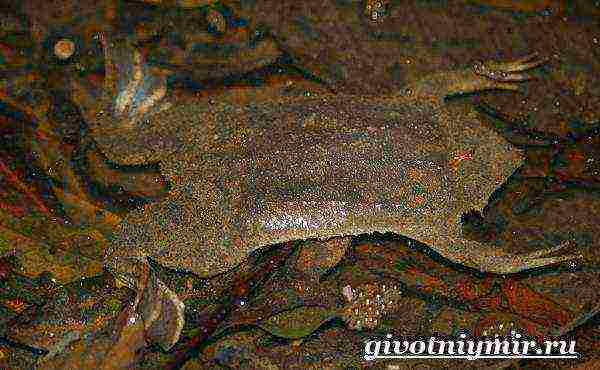
The body of an average individual does not exceed 12 cm, but there are also giants, the length of which can reach 20 cm. The skin of the Surinamese pipa is rough, wrinkled, sometimes with black spots on the back.
The color does not differ in bright colors, usually it is gray-brown skin with a lighter abdomen, often with a longitudinal dark stripe, suitable for the throat and encircling the frog's neck. In addition to the very lacking external data, pipa is "rewarded" by nature with a strong smell, reminiscent of the smell of hydrogen sulfide.
Surinamese pipa lifestyle and nutrition
Surinamese pipa inhabits in warm muddy bodies of water, without strong currents. The American pipa is also found in the neighborhood of people - in the irrigation canals of plantations. The favorite muddy bottom serves as a food environment for the toad.
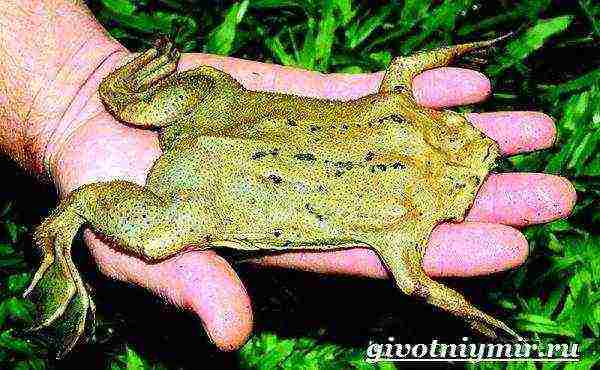
With its long fingers, the frog loosen up the viscous soil, dragging food into its mouth. Special skin growths on the front paws in the form of asterisks help her in this, which is why the pipu is often called "star-fingered".
The Surinamese pipa feeds organic residues that it digs into the ground. These can be fish pieces, worms, and other protein-rich insects.
Despite the fact that the frog has quite developed characteristic features of terrestrial animals (rough skin and strong lungs), pips practically do not appear on the surface.
Exceptions are periods of heavy rainfall in regions of Peru, Ecuador, Bolivia and other parts of South America. Then flat toads awkwardly crawl out of the water and embark on a journey hundreds of meters from home, basking in the warm muddy puddles of tropical forests.
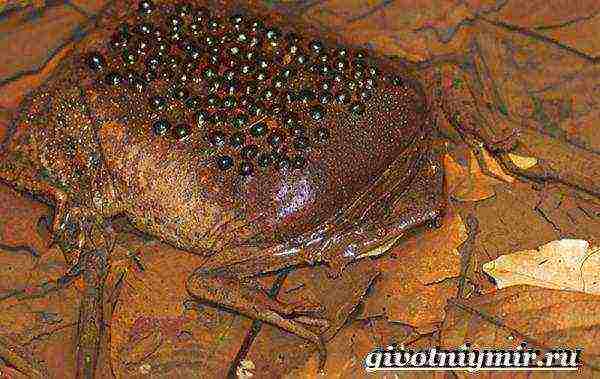
Thanks to the maternal skin, all pipa offspring always survive
Reproduction and life expectancy of the Surinamese pipa
The onset of seasonal rains is a signal for the onset of the period reproduction.Surinamese pip heterosexual, although outwardly it is rather difficult to distinguish a male from a female. The male begins mating dance with a "song".
By emitting a metallic click, the gentleman makes it clear to the female that he is ready for mating. Approaching the chosen one, the female begins to throw unfertilized eggs directly into the water. The male immediately releases sperm, giving rise to a new life.
After that, the expectant mother sinks to the bottom and catches eggs ready for development right on her back. The male plays an important role in this action, evenly distributing the eggs along the female's back.
With its abdomen and hind legs, it presses each egg into the skin, thus forming a semblance of a cell. After a few hours, the frog's entire back becomes honeycomb. Having finished his work, the negligent father leaves the female along with the future offspring. This is where his role as head of the family ends.
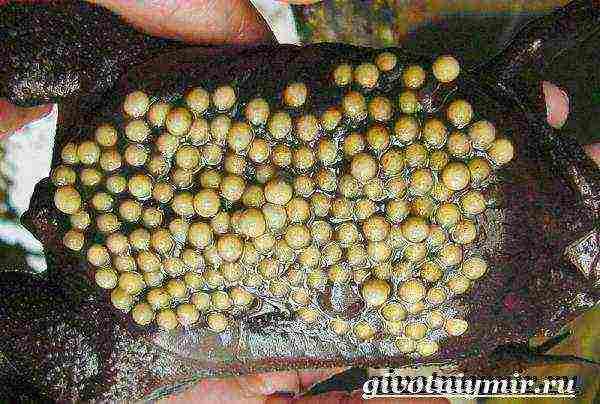
In the photo there are pipa eggs attached to her back.
For the next 80 days, the pipa will carry eggs on its back, reminiscent of a kind of mobile kindergarten. In one litter, the Surinamese toad gives birth to up to 100 small frogs. All offspring, located on the back of the expectant mother, weigh about 385 grams. Agree, not an easy burden for such a puny amphibian.
When each egg has settled in its place, its outer part is covered with a strong membrane that performs a protective function. The cell depth reaches 2 mm.
Being in the mother's body, the embryos receive from her body all the nutrients necessary for development. The “honeycomb” partitions are abundantly supplied with blood vessels that supply food and oxygen.
After 11-12 weeks of maternal care, young peeps break through the film of their personal cell and break out into a huge water world. They are quite independent in order to lead a lifestyle as close as possible to the lifestyle of an adult.
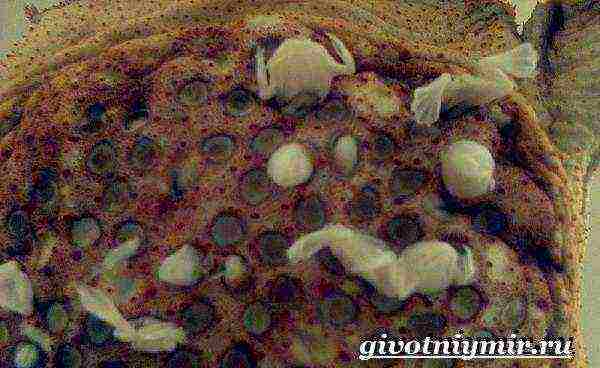
In the photo, young pips are leaving their cells
Although babies are born from the mother's body formed, this phenomenon is not considered "live birth" in its true meaning. Eggs develop in the same way as in other representatives of amphibians; the only difference is the place of development of the new generation.
Freed from young frogs, back of a Surinamese pipa requires updating. To do this, the toad rubs its skin against stones and algae, thereby discarding the old "child's place".
Until the next rainy season, the peep frog can live for its own pleasure. Young animals will be capable of independent reproduction only upon reaching the age of 6.

In the photo, the back of a pipa after the birth of small toads
Breeding Surinamese pipa at home
Neither the appearance nor the pungent smell stop exotic lovers from breeding this amazing animal at home. Observing the process of gestation of larvae and the birth of small frogs is fascinating not only for children, but also for adults.
In order for the pipa to feel comfortable, you need a large aquarium. One frog needs at least 100 liters of water. If you plan to purchase two or three individuals, add the same amount to each.
The water should be well aerated, so take care of such a system for saturating the aquarium with oxygen in advance. The temperature regime must be carefully monitored. The mark should not be higher than 28 C and below 24 C heat.
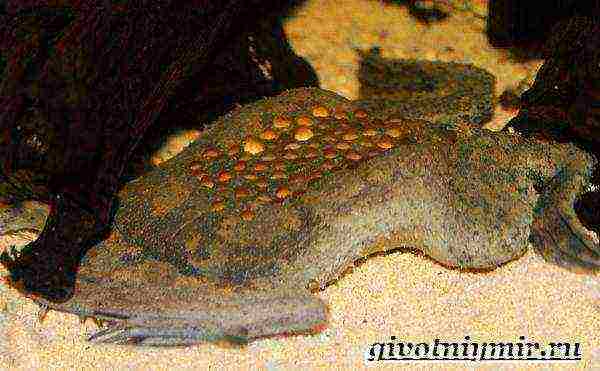
Fine gravel with sand is usually poured at the bottom. Artificial or live algae will help the Surinamese toad feel at home. Pips are not whimsical in food. Dry food for amphibians is suitable for them, as well as larvae, earthworms and small pieces of live fish.
Bowing to the surprisingly strong maternal instinct for amphibians, children's writer (and biologist) Boris Zakhoder dedicated one of his poems to the Surinamese pipa. Such a distant and little-known frog became famous not only in South America, but also in Russia.
»Amphibians» Which frog bears its offspring on its back?
In some countries of South America, you can find a very caring frog - pipu surinamese... Its peculiarity lies in the fact that she places all her future children on her wide back, and each in a separate cell. All day long, both parents carefully lay eggs, and then wait for small frogs to emerge from them. They have to wait a long time - more than 80 days - but parents do not have to worry about the nutrition of their babies: they get all the necessary substances from their mother's body. Interestingly, after the frogs are born, the Surinamese pipa changes its skin, thereby cleansing it of unnecessary cells.
Share this
Goes
 The Surinamese pipa is a very unusual frog that can be found mainly in South America in the waters of the Amazon River. The Surinamese pipa belongs to the class of amphibians, and the pipin family. This unique toad can carry its offspring for three months on its own back.
The Surinamese pipa is a very unusual frog that can be found mainly in South America in the waters of the Amazon River. The Surinamese pipa belongs to the class of amphibians, and the pipin family. This unique toad can carry its offspring for three months on its own back.
Features and description of the Surinamese pipa
The first difference from other amphibians is her physique. When you first see such a frog, you might think that it was run over by a skating rink several times. Its body is very thin and flattened, it is very similar to a large, old leaf of some tree, and it is very difficult to even assume that this is an inhabitant of a tropical river with warm water.
The head of the Surinamese toad has a triangular shape and is as flattened as the entire body of the frog. Eyes located on top of the muzzle, they have no eyelids and are very small. It is worth noting that these frogs have no teeth or tongue. Instead, the toad has scraps of skin that are found in the corners of the mouth and are very similar to tentacles.
The front legs of an amphibian are without membranes and end with long toes that do not have claws, this is one more difference from other frogs. And on the hind limbs there are skin folds, they are very powerful and are located between the toes. These folds enable the frog to feel confident underwater.
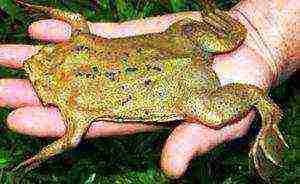 The body of a not very large frog does not exceed twelve centimeters, but there are giants, their length can reach twenty centimeters... The skin of this unusual animal is very rough and wrinkled, sometimes you can see black spots on the back.
The body of a not very large frog does not exceed twelve centimeters, but there are giants, their length can reach twenty centimeters... The skin of this unusual animal is very rough and wrinkled, sometimes you can see black spots on the back.
The color of the Surinamese pipa is dim, they mainly have gray-brown skin and a light belly, there may also be a dark stripe that goes to the throat and covers the toad's neck, forming a border on it. In addition, an already not very attractive animal has a strong smell that resembles the smell of hydrogen sulfide.
Frog lifestyle and nutrition
The habitat of this frog is reservoirs with warm and muddy water, which do not have a strong current. INshe also meets near people, near plantations in irrigation canals. She really likes the muddy bottom, which is the feeding medium of the pipa.
With her long fingers, which are on the front paws, she loosens the soil and looks for food, then drags it into her mouth. The helpers in this are growths on the legs, which are very similar to asterisks; therefore, the frog is called "star-fingered".
The Surinamese frog feeds on organic remains that are buried in the ground at the bottom of the reservoir. It can be:
- pieces of fish;
- worms;
- insects rich in protein.
Pipa frogs almost never appear on the surface, although they have all the signs of a land animal:
- very rough skin;
- strong lungs.
The exceptions are those periods when heavy rains fall in Bolivia, Peru, Ecuador and other cities in South America. When it happens surinamese toads appear on the shore and migrate hundreds of kilometers to find warm and muddy puddles near tropical forests, where they bask and bask in the sun.
Life span and reproduction
 The breeding season for Surinamese frogs begins when the rainy season arrives. These toads are heterosexual, although it is not an easy task to distinguish where the female is and where the male is. To conquer the female, the male must begin the mating dance, which is followed by a song.
The breeding season for Surinamese frogs begins when the rainy season arrives. These toads are heterosexual, although it is not an easy task to distinguish where the female is and where the male is. To conquer the female, the male must begin the mating dance, which is followed by a song.
In order for the female to understand that the male is ready to mate, he begins to emit a piercing click. Female, after he chooses a male, approaches him and throws unfertilized eggs into the water, and the male instantly begins to release sperm on them to give life to future offspring.
After some time, the female descends to the bottom to catch the eggs fertilized by the male, she catches them on her back. And the male at this time should evenly distribute the eggs on the back of the future mother.
He makes small cells on the female's back, pressing each egg separately, he helps himself with his hind legs and belly. After several hours of such work, the frog's back can be confused with a honeycomb. After the work done, the male leaves his future children and the female and never appears in their lives.
The Surinamese pipa will bear its offspring for approximately eighty days. A frog in one litter can produce about a hundred frogs, which are born at the same time. Baggage that is on the back of the female has a weight of about 385 grams, for a pip, it is not easy at all. After all the eggs are in their places, they are covered with a protective membrane, it is very strong and protects future offspring. The depth of the cells in which the eggs are located reaches two millimeters.
Being in the mother's body, the embryos take from her body all, without exception, the nutrients that are necessary for their development. The partitions that separate them from each other have many blood vessels, through which they receive oxygen and nutrition, the embryos.
Twelve weeks later, young frogs break through the protective film of their house and swim away into an unknown aquatic world. From birth, they are very independent and can lead a normal life alone, without the help of an adult.
This appearance of new small individuals is not considered live birth, although frogs appear from the body of the female. Egg development process, exactly, like other amphibians, the only difference is the place where they develop.
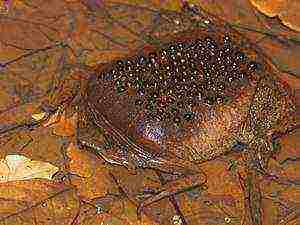 When a new generation is born, the back of the Surinamese frog needs immediate renewal. To do this pipa rubs his back about different algae and stones and this allows her to get rid of the place where the embryos developed.
When a new generation is born, the back of the Surinamese frog needs immediate renewal. To do this pipa rubs his back about different algae and stones and this allows her to get rid of the place where the embryos developed.
Until the next mating season, the frog can enjoy life and have nothing to worry about. Young frogs will be able to reproduce on their own when they are six years old.
Surinamese pipa at home
People who are fond of exotic animals breed these wonderful frogs at home, and their not very attractive appearance and the smell of hydrogen sulfide do not scare them at all. It is very interesting to follow how the female bears the larvae and how they are then born.
If you decide to start a pipu at home, then you will need a large aquarium. If you have one frog to live, then he should accommodate not less than one hundred liters of water, and if two or three, then spread it out so that the same amount falls on each individual, that is, three frogs need an aquarium for three hundred liters of water.
The water needs to be well oxygenated, so this needs to be thought about ahead of time. And also it is necessary to carefully monitor the temperature regime. The temperature should not exceed twenty-eight degrees and be less than twenty-four.
> Place sand and fine gravel at the bottom of the aquarium. And also there should be different living algae in it, this will help Surinamese frog feel comfortable. It is necessary to feed them with different food for amphibians, and they will also not give up on earthworms, larvae and small pieces of live fish.
Surinamese pipa toad. Surinamese pipa lifestyle and habitat
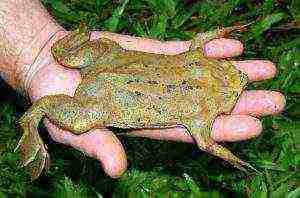
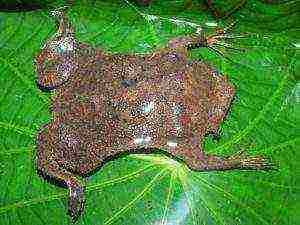
Surinamese pipa - toad, which can be found in the waters of the Amazon Basin in South America. This species belongs to the pipin family, a class of amphibians. A unique frog is capable of carrying offspring right on its back for almost three months.
Description and structural features of the Surinamese pipa
A distinctive feature of an amphibian is the structure of its body. If you look at photo of pipa of Suriname, you might think that the frog accidentally fell under the ice rink. A thin, flattened body looks more like an obsolete leaf of a tree than a living inhabitant of the warm waters of a tropical river.
The head is triangular in shape, and is also flattened like the body. Tiny eyes, devoid of eyelids, are located at the top of the muzzle. It is noteworthy that frog pipa surinamese missing tongue and teeth. Instead, at the corners of the toad's mouth there are skin patches that look like tentacles.
The front legs end in four long toes without claws, without membranes, as is the case with ordinary frogs. But the hind limbs are equipped with powerful folds of skin between the fingers. This allows the unusual animal to feel confident underwater.
The body of an average individual does not exceed 12 cm, but there are also giants, the length of which can reach 20 cm. The skin of the Surinamese pipa is rough, wrinkled, sometimes with black spots on the back.
The color does not differ in bright colors, usually it is gray-brown skin with a lighter abdomen, often with a longitudinal dark stripe, suitable for the throat and encircling the frog's neck.
In addition to the very lacking external data, the pipa is "rewarded" by nature with a strong smell, reminiscent of the smell of hydrogen sulfide.
Surinamese pipa lifestyle and nutrition
Surinamese pipa inhabits in warm muddy bodies of water, without strong currents. The American pipa is also found in the neighborhood of people - in the irrigation canals of plantations. The favorite muddy bottom serves as a food environment for the toad.
With its long fingers, the frog loosens the viscous soil, dragging food into its mouth. Special skin growths on the front paws in the form of asterisks help her in this, which is why the pipu is often called "star-fingered".
The Surinamese pipa feeds organic residues that it digs into the ground. These can be fish pieces, worms, and other protein-rich insects.
Despite the fact that the frog has quite developed characteristic features of terrestrial animals (rough skin and strong lungs), pips practically do not appear on the surface.
Exceptions are periods of heavy rainfall in regions of Peru, Ecuador, Bolivia and other parts of South America. Then flat toads awkwardly crawl out of the water and embark on a journey hundreds of meters from home, basking in the warm muddy puddles of tropical forests.
Thanks to the maternal skin, all pipa offspring always survive
Reproduction and life expectancy of the Surinamese pipa
The onset of seasonal rains is a signal for the onset of the period reproduction. Surinamese pip heterosexual, although outwardly it is rather difficult to distinguish a male from a female. The male begins mating dance with a "song".
By emitting a metallic click, the gentleman makes it clear to the female that he is ready for mating. Approaching the chosen one, the female begins to throw unfertilized eggs directly into the water.
The male immediately releases sperm, giving rise to a new life.
After that, the expectant mother sinks to the bottom and catches eggs ready for development right on her back. The male plays an important role in this action, evenly distributing the eggs along the female's back.
With its abdomen and hind legs, it presses each egg into the skin, thus forming a semblance of a cell. After a few hours, the frog's entire back becomes honeycomb-like. Having finished his work, the negligent father leaves the female along with the future offspring. This is where his role as head of the family ends.
In the photo there are pipa eggs attached to her back.
For the next 80 days, the pipa will carry eggs on its back, reminiscent of a kind of mobile kindergarten. In one litter, the Surinamese toad gives birth to up to 100 small frogs. All offspring, located on the back of the expectant mother, weigh about 385 grams. Agree, not an easy burden for such a puny amphibian.
When each egg has settled in its place, its outer part is covered with a strong membrane that performs a protective function. The cell depth reaches 2 mm.
Being in the mother's body, the embryos receive from her body all the nutrients necessary for development. The “honeycomb” partitions are abundantly supplied with blood vessels that supply food and oxygen.
After 11-12 weeks of maternal care, young peeps break through the film of their personal cell and break out into a huge water world. They are quite independent in order to lead a lifestyle as close as possible to the lifestyle of an adult.
In the photo, young pips are leaving their cells
Although babies are born from the mother's body formed, this phenomenon is not considered "live birth" in its true meaning. Eggs develop in the same way as in other representatives of amphibians; the only difference is the place of development of the new generation.
Freed from young frogs, back of a Surinamese pipa requires updating. To do this, the toad rubs its skin against stones and algae, thereby discarding the old "child's place".
Until the next rainy season, the peep frog can live for its own pleasure. Young animals will be capable of independent reproduction only upon reaching 6 years of age.
In the photo, the back of a pipa after the birth of small toads
Breeding Surinamese pipa at home
Neither the appearance nor the pungent smell stop exotic lovers from breeding this amazing animal at home. Observing the process of carrying the larvae and the birth of small frogs is fascinating not only for children, but also for adults.
In order for the pipa to feel comfortable, you need a large aquarium. One frog needs at least 100 liters of water. If you plan to purchase two or three individuals, add the same amount to each.
The water should be well aerated, so take care of such a system for saturating the aquarium with oxygen in advance. The temperature regime must be carefully monitored. The mark should not be higher than 28 C and below 24 C heat.
Fine gravel with sand is usually poured at the bottom. Artificial or live algae will help the Surinamese toad feel at home. Pips are not whimsical in food. Dry food for amphibians is suitable for them, as well as larvae, earthworms and small pieces of live fish.
Bowing to the surprisingly strong maternal instinct for amphibians, children's writer (and biologist) Boris Zakhoder dedicated one of his poems to the Surinamese pipa. So distant and little-known frog became famous not only in South America, but also in Russia.
Surinamese pipa toad. Surinamese pipa lifestyle and habitat


All kinds of living creatures can not be found in the wild. Each has its own difference, special uniqueness. It would seem that they are ordinary toads, what can be unusual about them. It is worth getting to know them better.
Description and structural features of the Surinamese pipa
Pipssurinamese This toads, belonging to the amphibian tailless pipin family. South America, Brazil, Peru, Suriname - all these countries, places habitatSurinamesepips.
She settles in lakes and rivers. It can also be found on farm plantations in an irrigation canal. And nothing in this life can force the frogs to get out of the water.
Even during periods of great drought, she, somewhere, but will find a dirty, small, silted puddle and will wait in it until the onset of more favorable conditions for her life.
And with the onset of the rainy seasons, she begins a new, travel-filled life.From puddle to puddle, from reservoir to reservoir, she will wander, making her way behind the stream of streams. And so the traveler toad will freely float around the entire perimeter around it along and across.
But, despite her unearthly love for water, she can lead a terrestrial life absolutely without any harm to her health. Light frogs are well developed, and it also has a rather coarse skin, which allows it to be freely even in the sun.
Look at photo of a Surinamese pipa, the frog itself is an obvious incredible animal. From a distance, it can be confused with some kind of leaf or piece of paper.
It is like a fifteen centimeter flat quadrilateral, which ends in triangles at one end, with an acute angle. It turns out that that acute angle is the head of the frog itself, imperceptibly emerging from the body.
The eyes of an amphibian are located far from each other, on both sides of the head and look up. This animal has no tongue, and near the corners of its mouth there are clumps of skin resembling tentacles.
The front paws of the animal are not at all similar to the paws of their congeners; there are no membranes between its four fingers, with the help of which the frogs swim. With her forelimbs, she gets food, raking kilograms of silt, which is why she has long strong phalanges.
On the very edges of the fingers have grown, in the form of warts, small processes in the shape of an asterisk. Therefore, many are familiar with them as star-fingered Surinamese pips.
The hind legs are larger than the front ones, there are membranes between the toes. With their help, the pipa swims well, especially during his travels.
The color of the frog is frankly a camouflage color, to match the tone of the dirt in which it is picking, whether it is dark gray, or dirty brown. Its abdomen is slightly lighter, and some have a dark stripe along its entire length.
But what distinguishes the Surinamese pipa from all other frogs is its hyper motherhood. The thing is that Surinamese pipa bears his children on his own back... In the same place on the back, by nature, it has special depressions, the sizes suitable for the development of tadpoles.
This frog has one drawback, its awful smelling "scent" of the body. Perhaps nature here came to her aid, firstly, more than one predator who wanted to eat a pipa could not stand such a smell.
Secondly, with its smell, the amphibian notifies of its presence, since due to its appearance it is not too noticeable. And hiding in a drought, in a small dirty puddle, you can easily crush it, simply not seeing it, but because of the stench, it is impossible not to smell it.
Surinamese pipa lifestyle and nutrition
Living all its life in water among algae, mud and rotten driftwood, pipa leads a fish lifestyle and feels comfortable. She has completely atrophied eyelids, palate and tongue.
However, accidentally getting out, the Surinamese pipa turns into a sloth. She awkwardly, slowly trying to crawl somewhere, and having reached the nearest swamp, she no longer leaves it until it is completely dry.
If the frog crawls to the river, then it chooses those places where there is no current.Feeds onsurinamesepipa mostly in the dark. They look for their food at the bottom of the reservoir in which they settled.
With their long, four-fingered forelimbs, the pipy loosen up the silt that got in the way, and with the help of star-shaped wart processes they find food. Everything that pops up is mainly small fish, worms, bloodworms, the Surinamese frog drags into its mouth.
Reproduction and life expectancy
Surinamesepips, ready for reproduction then, when her body grows to the size of a matchbox, that is, five centimeters. Pip toads reach this size in the sixth year of their life. Pipa boys differ slightly from their girls in darker color and smaller size.
Before mating, like a gallant gentleman, the male sings serenades to his chosen one, clicking and whistling. If the lady is not disposed to meet, the gentleman will not insist. Well, if the female is ready, she freezes for a moment and starts a small tremor. For the male, this behavior is a guide to action.
They have mating dances, or rather, everything that happens, lasting a day, is very similar to dances. The female begins to lay eggs, the male, using all his dexterity and dexterity, catches them and carefully puts them in each "mini house" located on the back of the expectant mother.
The female can lay from sixty to one hundred and sixty eggs. But she does not do it right away. Gradually, the frog lays ten sticky eggs, the male deftly places them on the female's back, clinging to her with his belly.
The man immediately fertilizes the eggs, and compactly putting each one in his house with the help of his hind legs, presses his tummy against the female's back, as if pressing them. Then, after ten minutes of rest, the process is repeated.
Some eggs may fall out of the papa's paws and stick to the vegetation, but they will no longer give a new life. When the lady finishes spawning, the male secretes a special mucus to seal each house until the offspring appear. Then, hungry and tired, he leaves his partner forever, this is where his mission is over. The female also swims away in search of food.
After a couple of hours, out of nowhere from under the "houses" for tadpoles, a certain liquid mass appears from the very bottom, which rises upward, attaching to itself all the garbage that was on the back of the toad.
Also, with the help of this mass, eggs are culling, those that are small and without embryos are also removed. After that, the pipa rubs his back against any surface in order to clean off all the dirt from himself.
For the next eighty days, the expectant mother will conscientiously carry eggs on herself. When the tadpoles are fully formed and ready for independent life, the tip of each egg swells and a small hole forms in it.
At first, it serves for the breathing of unborn children. Then, through it, the tadpoles get out. Some go tail first, some head.
From the side, looking at the frog, it can be seen that its back is dotted with the heads and tails of babies. Tadpoles very quickly leave their temporary dwelling and those who are stronger immediately rush to the surface of the water to breathe in air.
The weaker ones, having fallen to the bottom several times, still achieve their goal in another attempt to swim out. Then all of them, having gathered in one group, go to a new life that has not yet been experienced for them. Now they have to save themselves from enemies on their own, look for food for themselves, burrowing into the muddy bottom of the reservoir.
In the seventh week of their life, the tadpoles are ready for transformation and begin to turn into a frog. They grow three to four centimeters, first the hind legs are formed, then the front ones, and the tail soon disappears.
Well, an accomplished mother, having rubbed herself thoroughly on the stones, and having thrown off her old skin, is already in a new image ready for love adventures again. Surinamese pipes live in a favorable environment for up to fifteen years.
Breeding Surinamese pipa at home
For lovers of exotic and those who want to have such a toad, you need to know that it needs space. Therefore, the aquarium should be at least one hundred liters. If you put your unusual pet in a three hundred liter house, the toad will only be happy.
In no case do not add aquarium fish to the frogs, the pipa predator will certainly eat them. The upper surface of the aquarium is covered with a net or a lid with holes, otherwise the pip, suddenly bored at night, can get out of it and die.
The water temperature should be room temperature twenty-twenty-five degrees. You can take well-settled tap water.Also, it should not be salty, and well saturated with oxygen. The bottom of the aquarium can be covered with beautiful gravel, all vegetation can be placed there for beauty, the frog will not eat it anyway.
Well, you need to feed her with large bloodworms, fish fry, earthworm, daphnia, hamarus. You can give small pieces of raw meat. Pipa is a very voracious amphibian, she will eat as much as she is offered.
Therefore, to avoid obesity, control the amount of feed. If obesity begins at a young age, the frog's vertebrae are deformed and an ugly hump grows on its back.
It is important to know that Surinamese pips are shy, in no case should you knock on the glass of the aquarium with anything. In fright, she will rush about and can severely break against its walls.
Frog, Surinamese pipa, toad lifestyle and reproduction
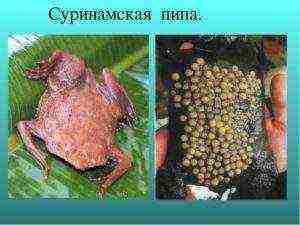
The Surinamese pipa is a very unusual frog that can be found mainly in South America in the waters of the Amazon River. The Surinamese pipa belongs to the class of amphibians, and the pipin family. This unique toad can carry its offspring for three months on its own back.
The first difference from other amphibians is her physique. Having seen such a frog for the first time, you might think that the ice rink ran over it several times. Its body is very thin and flattened, it is very similar to a large, old leaf of some tree, and it is very difficult to even assume that this is an inhabitant of a tropical river with warm water.
The head of the Surinamese toad has a triangular shape and is as flattened as the entire body of the frog. Eyes located on top of the muzzle, they have no eyelids and are very small. It is worth noting that these frogs have no teeth or tongue. Instead, the toad has scraps of skin that are found in the corners of the mouth and are very tentacle-like.
The front legs of an amphibian are without membranes and end with long toes that do not have claws, this is one more difference from other frogs. And on the hind legs there are skin folds, they are very powerful and are located between the toes. These folds allow the frog to feel confident underwater.
The body of a not very large frog does not exceed twelve centimeters, but there are giants, their length can reach twenty centimeters... The skin of this unusual animal is very rough and wrinkled, sometimes you can see black spots on the back.
The color of the Surinamese pipa is dim, they mainly have gray-brown skin and a light belly, there may also be a dark stripe that goes to the throat and covers the toad's neck, forming a border on it. In addition, an already not very attractive animal has a strong smell that resembles the smell of hydrogen sulfide.
Frog lifestyle and nutrition
The habitat of this frog is reservoirs with warm and muddy water, which do not have a strong current. INshe also meets near people, near plantations in irrigation canals. She really likes the muddy bottom, which is the feeding medium of the pipa.
With her long fingers, which are on the front paws, she loosens the soil and looks for food, then drags it into her mouth. Helpers in this are growths on the legs, which are very similar to asterisks, which is why the frog is called "star-fingered".
The Surinamese frog feeds on organic remains that are buried in the ground at the bottom of the reservoir. It can be:
- pieces of fish;
- worms;
- insects rich in protein.
Pipa frogs almost never appear on the surface, although they have all the signs of a land animal:
- very rough skin;
- strong lungs.
The exceptions are those periods when heavy rains fall in Bolivia, Peru, Ecuador and other cities in South America. When it happens surinamese toads appear on the shore and migrate hundreds of kilometers to find warm and muddy puddles near tropical forests, where they bask and bask in the sun.
Life span and reproduction
The breeding season for Surinamese frogs begins when the rainy season arrives. These toads are heterosexual, although it is not an easy task to distinguish where the female is and where the male is. To conquer the female, the male must begin the mating dance, which is followed by a song.
In order for the female to understand that the male is ready to mate, he begins to emit a piercing click. Female, after he chooses a male, approaches him and throws unfertilized eggs into the water, and the male instantly begins to release sperm on them to give life to future offspring.
After some time, the female descends to the bottom to catch the eggs fertilized by the male, she catches them on her back. And the male at this time should evenly distribute the eggs on the back of the future mother.
He makes small cells on the back of the female, pressing each egg there separately, he helps himself with his hind legs and belly. After several hours of such work, the frog's back can be confused with a honeycomb. After the work done, the male leaves his future children and the female and never appears in their lives.
The Surinamese pipa will bear its offspring for approximately eighty days. A frog in one litter can produce about a hundred frogs, which are born at the same time.
Baggage that is on the back of the female has a weight of about 385 grams, for a pip, it is not easy at all. After all the eggs are in their places, they are covered with a protective membrane, it is very strong and protects future offspring.
The depth of the cells in which the eggs are located reaches two millimeters.
Being in the mother's body, embryos take from her body all, without exception, the nutrients that are necessary for their development. The partitions that separate them from each other have many blood vessels, through which they receive oxygen and nutrition, the embryos.
Twelve weeks later, young frogs break through the protective film of their house and swim away into an unknown aquatic world. From birth, they are very independent and can lead a normal life alone, without the help of an adult.
This appearance of new small individuals is not considered live birth, although frogs appear from the body of the female. Egg development process, exactly, like other amphibians, the only difference is the place where they develop.
When a new generation is born, the back of the Surinamese frog needs immediate renewal. To do this pipa rubs his back about different algae and stones and this allows her to get rid of the place where the embryos developed.
Until the next mating season, the frog can enjoy life and have nothing to worry about. Young frogs will be able to reproduce on their own when they are six years old.
Surinamese pipa at home
People who are fond of exotic animals breed these wonderful frogs at home, and their not very attractive appearance and the smell of hydrogen sulfide do not scare them at all. It is very interesting to follow how the female bears the larvae and how they are then born.
If you decide to start a pipu at home, then you will need a large aquarium. If you have one frog to live, then he should accommodate not less than one hundred liters of water, and if two or three, then spread it out so that the same amount falls on each individual, that is, three frogs need an aquarium for three hundred liters of water.
The water needs to be well oxygenated, so this needs to be thought about ahead of time. And also it is necessary to carefully monitor the temperature regime. The temperature should not exceed twenty-eight degrees and be less than twenty-four.
At the bottom of the aquarium, sand and fine gravel should be poured. And also there should be different living algae in it, this will help Surinamese frog feel comfortable.It is necessary to feed them with different food for amphibians, and they will also not give up earthworms, larvae and small pieces of live fish.
Who is the Pipa of Surinamese?
The Surinamese pipa is a frog that lives in South America and is predominantly nocturnal. It can be found in Bolivia, Peru, Ecuador, Suriname, Brazil or Colombia.
The frog spends most of its life in water bodies, only occasionally appearing on land during heavy rains, then it very awkwardly moves through the flooded rainforest.
It is noteworthy that even during a severe drought, it does not leave the water, preferring to wait out the heat in small and almost dried puddles.
Despite the fact that this amphibian has rough keratinized skin and well-developed lungs - signs of a terrestrial form of existence, it does not like dry land.
This frog prefers natural bodies of water with a muddy bottom and muddy water. The Surinamese pipa is most often found in ponds and slow-flowing rivers belonging to the Amazon basin.
Sometimes it can be seen in the irrigation ditches of plantations.
Many people dislike and even fear common frogs. But the Surinamese pipa is distinguished by its special appearance. Jokesters might say that this frog looks like it was hit by an ice rink.
She is actually very puny. Gray or brown, almost flat body with a triangular head, motionless eyes and a pair of tentacles at the mouth. The abdomen is light, sometimes with a black stripe or several white spots.
In length, an adult frog can reach 20 cm.
Fore tarsus almost without webbing, with long toes, on the tips of which very sensitive star-shaped appendages can be seen. Because of them, the frog is called the starfinger. Another interesting anatomical feature of this animal is the absence of tongue and teeth. The Surinamese pipa usually looks for food at the bottom, fingering silt with its front paws.
The hind ones are long and strong, their fingers are connected by membranes, which allows the frog to move perfectly in the water. It should be noted that in addition to such an ugly appearance, pipa has a pungent, very unpleasant odor, reminiscent of sulfur. Nevertheless, many amphibian lovers prefer to keep this exotic animal at home in an aquarium.
What caused such a desire?
Pipa of Suriname is a wonderful mother, and it is very interesting to watch how she carries babies. Mating occurs only during the rainy season. It all starts with a mating dance. The male makes a metallic clicking sound, calling for the female.
Soon she begins to throw eggs, and the male fertilizes them and presses them with the breast and hind legs to the female's back, painstakingly distributing the eggs among the cells.
It is there that small pips will live and develop for two and a half months.
The cells themselves are deep - about 1.5 cm, and the size of the eggs is up to 7 mm. The partitions in the cells contain a huge number of blood vessels. The protruding part of each egg is covered with a dense stratum corneum.
Mating can last a day, then the male considers his mission completed and leaves.
The tadpoles will be in such a "kindergarten" for 11-12 weeks, where everything is provided - protection, nutrition and an ideal temperature regime.
Reproduction
The Surinamese pipa, whose reproduction is much different from that of other frogs, can lay over 100 eggs and then carry them all for about 85 days. The total egg-laying weight is approximately 385 grams.
For a frog, this is a fairly large figure. After the expiration date, fully formed young pips leave their cells. The frog removes the remnants of the skin. To do this, she rubs her back against plants or stones. New skin appears soon after shedding.
Home content
To bring this miracle of nature at home, you need to carefully prepare. For this frog, you need an aquarium with a volume of at least 100 liters, but it is better to buy for 200-300 liters.The next step is to select a filter. The water in the aquarium should be warm (about 26 degrees) and well aerated.
Fine gravel can be poured on the bottom, and the aquarium itself can be decorated with live or artificial algae. Feeding a Surinamese pipa is easy. Bloodworms, earthworms and small fish are perfect for this purpose. Lovers who want to breed such unusual animals should be aware that puberty in these frogs occurs at the age of 6 years.
Conclusion
Once, having seen for the first time how the Surinamese pipa takes care of its offspring in an extraordinary way, Zakhoder Boris wrote a beautiful poem dedicated to her maternal feelings. So this frog became famous.
Many admire the maternal instincts of a cat or dog, but nature has not only endowed them with excellent parenting qualities. And even if the male of the Surinamese pipa does not care about his offspring, like a leaf frog, for example, the female does an excellent job alone, providing her babies with everything they need.
In the end, I would like to note, no matter what kind of mother she looks like - beautiful or ugly, for her children she still remains the most wonderful and beloved.
Toad pipa surinamese in the aquarium
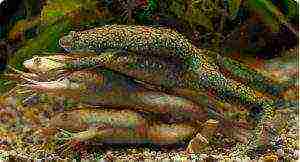
The Surinamese pipa toad is an interesting inhabitant of the aquarium! The aquarium in the house is both an attractive piece of furniture and a unique opportunity to observe the world in which the underwater inhabitants live. In people's homes, freshwater aquariums are more common, in which bright tropical fish live.
Less often you can see marine aquariums with amazing inhabitants of warm seas.
Of course, watching the fish is interesting, but they don't do anything special. And the aquarium becomes commonplace, which has ceased to amaze. Everything can be changed if you get an unusual inhabitant, which will be interesting to watch.
Instead of fish, you can put a pipu toad in an aquarium, which is rarely kept by Russian aquarists.
The Surinamese pipa is a toad that lives in small bodies of water in Ecuador, Bolivia, Suriname, Peru and Brazil. She lives in water, moves slowly and awkwardly on land.
Appearance
Looking at this amphibian in its natural environment, you might think that it is a woody leaf with sharp tips that has fallen into the water. The body of a pipa resembles just such a leaf. The head is triangular; it has no transition to the body. The body is quadrangular.
The toad's eyes are small, looking up. Small patches of leather hang at the corners of the mouth. The Surinamese pipa is a rather large amphibian, it can reach a length of almost 20 cm. Only the goliath frog is larger than it.
The front legs of the pipa are thinner than the hind legs, which are also much thicker. On the hind legs, the toes are thin with sharp ends, connected by a skin fold - a membrane.
In adult females, the skin on the back becomes folds, in some cases cells are visible. The color of the toad is from gray to dark brown. The abdomen is almost white, sometimes with a dark stripe.
Life in nature
The toad settle in small ponds, irrigation canals. Pipa does not leave the aquatic environment throughout its life. In order to get food, the pipa digs out the bottom soil with its front paws and grabs pieces of food from the raised turbidity. It can also eat stationary edible objects.
in aquarium
For a comfortable life of a pair of toads in captivity, you need a large aquarium. From 100 to 300 liters. The bottom of the aquarium is covered with small pebbles, although they do just fine without it. Plants, both live and artificial, can be used as decorations.
The aquarium must have a powerful filter. Pips need warm water, the temperature of which is not lower than + 27C. You can feed these strange animals with live food for large fish and small fish.
Reproduction
The weirdness of the pipa toad is how it reproduces. Little frogs emerge right from the back of the mother frog. And these are not tadpoles, but fully formed frogs.And their number is not one or two or three, but about a hundred.
Naturally, the appearance of frogs cannot be called childbirth in the full sense. Eggs develop in the same way as in all other amphibians. The only difference is the place where they develop.
In order for the frogs to appear, both parents take part in this process. As soon as the female lays the egg, the male picks it up and places it on the female's back in a special depression that appears at the pipa at the time of breeding.
This is how the male acts with all the eggs laid, and there are from 50 to 150 eggs. So that the eggs are better fixed on the back of the female, he presses them with his stomach.
The cavities in which the eggs are located quickly increase in size and become honeycomb-like. From the top of the egg, due to its drying, an almost transparent lid is formed. It is in these honeycomb depressions that future frogs grow, going through all the stages of development of amphibians.
First, an embryo appears, which over time becomes a tadpole. Further development takes place in the same deepening. The tadpoles become small frogs.
The development and maturation of embryos in warm water will take 10-12 days. If water is at room temperature, the development of embryos slows down to 15 days.
When the time comes to go out into the adult world, the little pips lift the dome lid, which at that time has already swollen, and float out of the cozy cradle on the frog's mother's back.
Strong frogs quickly leave the mother's back, weaker ones emerge slowly, often with their hind legs forward.
Babies, leaving their nest, swiftly swim to the surface to start breathing. After two days, they begin to feed on their own.
After all the frogs have left the back, the female begins to rub her back against the stones, removing the remnants of the egg shells. After molting, the Pipa Surinamese toad is ready for a new mating!
Meet pipa surinamese 🙂
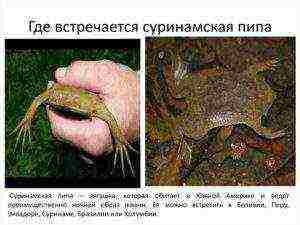
Surinamese pipa (Pipa pipa) is distinguished by an ugly, almost quadrangular and flat body, triangular, with a pointed head towards the muzzle, which is not separated from the body, and slender front legs.
The toes of the forelegs at the end have several processes, which is why the pipu was called "star-fanged" (Asterodactylus); the hind legs are thicker and rather long, with long, sharp toes connected by full swimming membranes; in old animals, the skin on the back is folded, and in old females it is even cellular; one or two pairs of tentacles are seen before the eyes, on the sides of the upper jaw, and another pair hangs near the corners of the mouth.
I suggest you get to know this miracle better, it's worth it.
Distributed in South America. The area covers Bolivia, Colombia, Ecuador, Peru and Brazil. Leads an aquatic lifestyle, settling, as a rule, in small natural reservoirs or in irrigation canals on plantations. The genus pip has 7 species. Its representatives do not leave the water throughout their lives.
There are no membranes on the front legs, but there are long thin fingers - just like a musician! True, with their help, the pipa does not play the piano, but loosens the bottom silt, extracting something edible from there. On the tips of the fingers are leathery star-shaped appendages, for which the Surinamese pip is often called starpaw.
Strong hind legs with normal frog membranes serve them for locomotion in the water. The color of the flattened twenty-centimeter body of adult pips varies from blackish-brown to gray. The belly is light, but sometimes a dark stripe runs along it.
Pip frogs (Latin Pipidae) are a family of tailless amphibians. The peculiarity of pip is the absence of a language.
Surinamese pip can be found not only in ponds and rivers, but also in irrigation canals on plantations. Even a prolonged drought cannot force them to get out on solid ground - pips prefer to sit in half-dried puddles.But in the rainy season, they take their souls away, traveling through rain-flooded forests.
Such a strong love for water is surprising, because the Surinamese pip has well-developed lungs and rough keratinized skin, which is typical for terrestrial animals. Their body looks like a small, flat, quadrangular leaf with sharp corners on the sides. The triangular head smoothly merges into a frail body. The eyes are turned upward, with tentacular skin flaps located near the corners of the mouth.
The pipa uses the scavenger strategy to get food. With her front limbs, she digs up the soil, stirring up the silt, and snatches food particles out of it. Can also be used for food and stationary objects. For keeping pip use spacious aquariums.
The volume should not be less than 100 liters per steam, but better than 200 - 300. Fine gravel can be poured on the bottom, although piping can do without soil. The aquarium can be decorated with live and artificial plants, good water filtration is required. The optimum temperature is 26 degrees.
Food - large bloodworms, earthworms, small fish.
If you want to have this miracle of nature in your apartment, you will have to purchase a spacious aquarium for 100, or better for 200 or 300 liters, decorate it with live or artificial plants and pour fine gravel on the bottom. The water in it should be warm (about 26 degrees) and well aerated. You can feed the Surinamese pip with bloodworms, earthworms and small fish.
Former travelers say that the pipa lives in dark forest swamps, crawls slowly and awkwardly on the ground and spreads a piercing smell, similar to the smell of burning sulfur.
Observers mostly describe the strange way of breeding pipa, confirming the information provided by Sibylla Merian, and refuting only her erroneous assumption that young pipas are born on the back of the mother.
Pipfrogs and toads live almost entirely in the aquatic environment. To do this, they have flattened organs and relatively large membranes on their paws compared to the rest of the body.
Manyreptiles developed along a completely unique evolutionary path in a relatively small geographical area.
There are several different types of Surinamese toads. The common pipa species is better known as the common Surinamese toad.
Unlike other tongueless toads, Surinamese toads have sensitive areas on the tips of their forepaws. They have no claws and are mostly nocturnal.
When people first saw what was happening with the Surinamese pipa, they could not believe their own eyes: the pipa kids appeared right from the back.
And not just any, but fully formed ones. And not one or two, but several dozen. An excellent connoisseur of nature and animals, the English naturalist D. Darrell, who once observed the birth of pipa cubs, wrote: Already before that I had to witness the greatest multitude of very different births. But only on rare occasions did what I saw absorbed and amazed me, as on that night ..
Of course, the appearance of children from the back of a pipa is not at all childbearing in the true sense of the word. Eggs and larvae of pipa develop, like eggs and larvae of all other amphibians. Only it happens in an unusual place.
As soon as the female lays an egg, the male picks it up and carefully puts it on the female's back, in a special cell. He does the same with the second, and third, and fourth, and with all the other eggs. So that they hold on better, he presses them with his chest.
The cells in which the eggs are laid become deeper every day and acquire a six-sided, honeycomb-like shape, and the eggs seem to grow into the back of the female. At the same time, the upper part of each egg dries up, forming a translucent dome.
It is there, in these honeycombs, under the translucent dome-lids, that everything that is supposed to happen happens.
First, embryos develop, then tadpole larvae appear, they also develop and turn into tiny toads.
There is enough moisture in such honeycomb-cells, the embryos and larvae receive nutrition through the walls of the cells from the mother's body.
Once formed, the tiny creatures raise the dome-lids, survey the unfamiliar world and, plucking up courage, climb out of their cradles. They are not together with their mother, but soon they leave her and begin an independent life.
Pipa can lay up to 114 eggs and carry this weight on itself for 80-85 days. If one egg at the initial stage weighs 2.97 grams, and at the end - 3.37 grams, multiply this by 114. And as a result, she carries 384.16 grams on herself. Not a little.
In the cell, frogs are almost completely formed and crawl out ready for life. When the kids have finally left this "mobile kindergarten", the pipa rubs against stones or plants and wipes off the remnants of the skin. After shedding, it is covered with new skin.
Suriname Pipa Suriname Pipa! You know, no doubt, with her? You are unfamiliar? for the beast
Surinamese Pipa!
Although she lives in a remote country - in Suriname And therefore rarely, poor thing, Meets us; Although she is ugly (Only modesty adorns her!), Even though she is from the family of frogs - Get to know her
Very, very does not interfere!
... There, In the shade of algarroba, quebracho And other exotic flora, In the evenings of frogs and toads Incessant choirs are leading. Among croaking, Ukanya, Squeak, rumbling and wheezing, your clear voice is heard, Surinamese Pipa!
. . . . . . . . . . . . . .
In frogs, family feelings, as a rule, are weak. About offspring.
Exceptionally gentle mom!
Yes, she doesn’t throw her way at all
Tadpoles grow up in them
They slowly grow up ... Until the deadlines are fulfilled -Children pull, and pull, and pull Juices from the mother ... And then they run away Jumping and completely forget about their mother. (It happens, According to rumors,
Not only in Suriname alone ...)
This is how the Surinamese Pipa lives. Now -I dare to hope -You would at least partially get to know her! If they ask you: "What kind of beast is the Surinamese Pipa?" -Answer: “This is a toad,
But a toad of a special type! "
Boris Zakhoder

